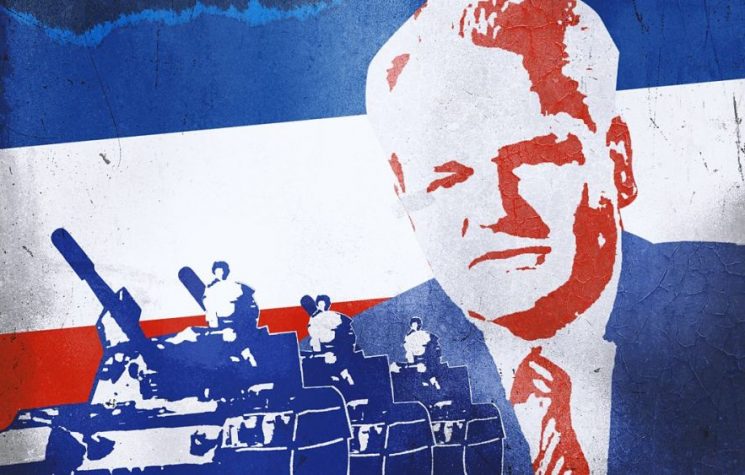U.S. deployment of nuclear strike aircraft to the UK signals to continental Europe that planning for nuclear war against Russia is accelerating.
On October 5 the U.S. State Department announced that the U.S. military’s arsenal of nuclear weapons numbered 3,750 as of September 30, 2020. It was stated with satisfaction that “This number represents an approximate 88 percent reduction in the stockpile from its maximum (31,255) at the end of fiscal year 1967”, although it wasn’t mentioned that the reduction since 2018 was only 35.
On the same day, the U.S. Defense Department publication Stars and Stripes reported that “an Air Force fighter jet slated to debut later this year in Europe passed a milestone when it dropped mock nuclear bombs during training flights designed to ensure its ability to fulfil NATO’s nuclear deterrence mission . . . The successful test of the F-35A Lightning II came as the 48th Fighter Wing, based at Britain’s RAF Lakenheath, reactivated the 495th Fighter Squadron last week for a new mission in Europe. [Emphasis added.] Ahead of the fighter model’s arrival at Lakenheath, two F-35As that took off from Nellis Air Force Base, Nevada, completed a full weapon system demonstration, regarded as a graduation flight test for achieving nuclear certification.”
In February 2021 U.S. Secretary of State Antony Blinken informed the Conference on Disarmament in Geneva that “President Biden has made it clear: the U.S. has a national security imperative and a moral responsibility to reduce and eventually eliminate the threat posed by weapons of mass destruction” and President Biden pledged to “take steps to reduce the role of nuclear weapons in our national security strategy,” but it has not been made clear how elimination of the threat from nuclear weapons or reduction of their role in U.S. military strategy can be achieved by training more combat aircraft pilots in the use of nuclear weapons and then deploying them to Europe with their strike aircraft.
The United Kingdom has an equally interesting perspective in what it describes as its “leading approach to nuclear disarmament” and is increasing its arsenal of nuclear weapons. As the Royal United Services Institute noted in March, the UK’s 2021 Integrated Review of Security, Defence, Development and Foreign Policy states that the UK is “raising a self-imposed limit on its overall nuclear warhead stockpile” of the current 225 warheads.
The Review, headed “Global Britain in a Competitive Age”, explains that in 2021 it had been announced as national policy that there would be a reduction in “our overall nuclear warhead stockpile ceiling from not more than 225 to not more than 180 by the mid-2020s. However, in recognition of the evolving security environment . . . this is no longer possible, and the UK will move to an overall nuclear weapon stockpile of no more than 260 warheads.” Then it assured the international community that in spite of increasing the number of its nuclear weapons delivery systems the United Kingdom is “strongly committed to full implementation of the NPT in all its aspects, including nuclear disarmament.”
It is intriguing that the present British government would have us believe that more nuclear weapons and deployment of 27 U.S. nuclear-capable F-35 aircraft to the UK’s Royal Air Force base at Lakenheath are in some fashion compatible with nuclear disarmament, but what is consistent is their linkage with the stockpiles of U.S. nuclear bombs already in Europe.
It is not known if there are or will be any U.S. nuclear weapons kept at Lakenheath, and no doubt the UK government would be comfortable with such storage which would add comparatively few bombs to the hundred or so already stored in vaults in air bases at Kleine Brogel in Belgium, Büchel in Germany, Aviano and Ghedi in Italy, Volkel in the Netherlands, and Incirlik in Turkey. It is regrettable that while the U.S. and Britain insist that they are trying to reduce the threat of nuclear war they are actually increasing and expanding numbers, locations and strike capabilities of nuclear weapons’ systems.
The U.S.-Nato military alliance policy is that “nuclear weapons are a core component of NATO’s overall capabilities for deterrence and defence,” resting almost entirely on U.S. nuclear delivery capabilities which are to be expanded at vast expense, with the new generation of Intercontinental Ballistic Missile Systems, now referred to as the Ground-Based Strategic Deterrent, likely to cost 95 billion dollars — if there are no cost overruns.
As stated by the Congressional Budget Office, it is “required by law to project the 10-year costs of nuclear forces every two years” and its latest paper, “Projected Costs of U.S. Nuclear Forces, 2021 to 2030” makes sobering reading because it is projected that U.S. taxpayers, in this era of fiscal crises, will be required to pay sixty billion dollars a year for nuclear forces over the next ten years. The Office estimates that “about $188 billion of the $551 billion total over the 2021–2030 period would go toward modernizing nuclear weapons and delivery systems. Of that amount, $175 billion would go toward modernizing the strategic nuclear triad, and $13 billion would be for modernizing tactical nuclear weapons and delivery systems.” And this does not include funding of such massive projects as the F-35 strike aircraft which will cost some $1.6 trillion.
The political justification for massive military spending on conventional and nuclear weapons by the governments in London and Washington is their contention that Russia and China pose a threat and that, in the words of the 2021 U.S. Interim National Security Strategic Guidance, Russia, for example, is “determined to enhance its global influence and play a disruptive role on the world stage.” (Presumably Washington means the sort of disruption that Associated Press reported on October 7 when “Europe’s soaring gas prices dropped . . . after Russian President Vladimir Putin suggested his country could sell more gas to European spot buyers via its domestic market in addition to through existing long-term contracts.”)
The surge in deployment of nuclear systems and the overall tenor of nuclear weapons developments in Europe do not meet with approval in the European community. For example, a survey published in January revealed that 74% of Italians, 58% of Dutch and 57% of Belgians and 83% of Germans want U.S. nuclear weapons removed from their countries, and another poll (albeit by the Campaign for Nuclear Disarmament) found that 77% of Britons favour a total ban on nuclear weapons.
Europe is in a state of flux, and not only because of the economic and social effects of the pandemic. For example, the Warsaw government’s recent refusal to abide by European Union laws could result in Poland leaving the EU (which would be greeted with approval by most EU citizens) but this would have no effect on the U.S.-Nato military buildup — the “Enhanced Forward Presence” along Russia’s borders, backed to the hilt by nuclear weapons.
U.S. deployment of a further squadron of nuclear strike aircraft to the UK, for a “new mission in Europe”, combined with its existing stocks of nuclear weapons in Europe and Britain’s undebated decision to increase its nuclear weapons’ arsenal are signals to continental European nations that planning for nuclear war against Russia is accelerating. While these countries prefer to engage with Washington and London in a balanced fashion and wish to maintain cordial relations, it would be advisable to question the motives behind the growing emphasis on nuclear war and insist on reduction in confrontational deployments.






















































